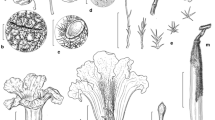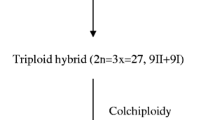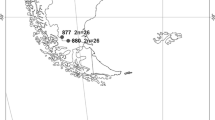Abstract
The genusCentaurium is represented in Amritsar District by three types of plants, distinguishable chiefly on the basis of flower-colour. The three races possess different chromosome numbers: white,n=18; purple,n=27; and cosmos,n=28.
A new basic number, 9, has been found to exist in the genus.
The white-flowered (4x) and purple-flowered (6x) races are, in all probability, alloploid in character. The exact nature of the cosmos-flowered race (n=28), however, is not known at present. It may either be an octoploid on the basic number 7, or a secondary polyploid from the hexaploid ofx=9 (2n=56=6x + 2=54=2). All the three colour-forms have been referred toE. ramosissima Pers. now calledC. pulchellum (Sw.) Druce by most taxonomists. However, the present investigation reveals that none of the races conforms strictly to this or to any other Indian species described by Hooker (1883). It appears that all or most of these species have arisen after extensive interspecific hybridization, which has resulted in a complete reticulation of characters. Furthermore,C. pulchellum in itself is a complex withn=10, 18, 20, 27, 28. In order to have a clear picture of the relationships of the Indian formsvis-a-vis their European counterparts, it is essential to conduct a well-planned biosystematic investigation based on samples from the entire range.
The taxonomic tangle and synonymy needs to be clarified by reference to the type material.
Similar content being viewed by others
References
Darlington, C. D. ..Chromosome Botany, London, 1956.
Druce, G. C. ..The Flora of British Isles, 1932, pp. 200–01.
Hooker, J. D. ..Flora of British India, 1883,4.
Kashyap, S. R. and Joshi, A. C.Lahore District Flora, Lahore, 1936.
Khoshoo, T. N., Khushu, C. L. and Singh, R. “Intraspecific ployploidy within some North-West Indian Angiosperms,”Science and Cult., 1961,27, 83–84.
Maerz, A. and Paul, M. R. ..A Dictionary of Colour, New York, 1930.
Maheshwari, J. K...Flora of Delhi, CSIR, New Delhi, 1953.
Zeltner, L... “Contribution a l’etude cytologique des genresBlackstonia Huds. etCentaurium Hill,”Bull. Soc. Bot. Suisee, 1961,71, 18–24.
—————.. “Deuxieme contribution a l’etude Cytologique des genresBlackstonia Huds. etCentaurium Hill,”Bull. Soc. Neuchateloise Sci. Nat., 1962,85, 83–95.
—————.. “Recherches sur quelques taxa mediteraneens du genreCentaurium Hill,” Ibid., 1963,86, 93–100.
Author information
Authors and Affiliations
Rights and permissions
About this article
Cite this article
Khoshoo, T.N., Khushu, C.L. Biosystematics of Indian plants. Proc. Indian Acad. Sci. 63, 152–160 (1966). https://doi.org/10.1007/BF03051987
Received:
Issue Date:
DOI: https://doi.org/10.1007/BF03051987




